Related Research Articles
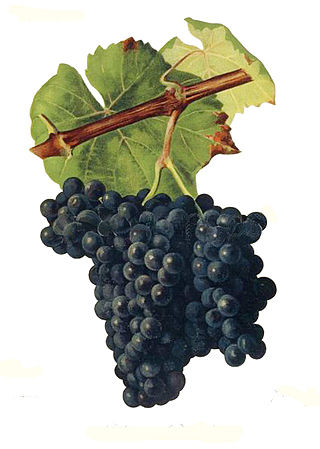
Alicante Bouschet or Alicante Henri Bouschet is a wine grape variety that has been widely cultivated since 1866. It is a cross of Petit Bouschet and Grenache. Alicante is a teinturier, a grape with red flesh. It is one of the few teinturier grapes that belong to the Vitis vinifera species. Its deep colour makes it useful for blending with light red wine. It was planted heavily during Prohibition in California for export to the East Coast. Its thick skin made it resistant to rot during the transportation process. The intense red color was also helpful for stretching the wine during prohibition, as it could be diluted without detracting from the appearance. At the turn of the 21st century, Alicante Bouschet was the 12th most planted red wine grape in France with sizable plantings in the Languedoc, Provence and Cognac regions. In 1958, Alicante Bouschet covered 24,168 hectares ; by 2011, plantings represented less than 4,000 hectares. This scenario is largely reversed in other regions of Europe, and in southern Portugal, where its wines are highly prized and frequently outscore traditional autochthonous varieties.

Tempranillo is a black grape variety widely grown to make full-bodied red wines in its native Spain. Its name is the diminutive of the Spanish temprano ("early"), a reference to the fact that it ripens several weeks earlier than most Spanish red grapes. Tempranillo has been grown on the Iberian Peninsula since the time of Phoenician settlements. It is the main grape used in Rioja, and is often referred to as Spain's noble grape. The grape has been planted throughout the globe's wine regions.

Portuguese wine was mostly introduced by the Romans and other ancient Mediterranean peoples who traded with local coastal populations, mainly in the South. In pre-Roman Gallaecia-Lusitania times, the native peoples only drank beer and were unfamiliar with wine production. Portugal started to export its wines to Rome during the Roman Empire. Modern exports developed with trade to England after the Methuen Treaty in 1703. From this commerce a wide variety of wines started to be grown in Portugal. In 1758, one of the first wine-producing regions of the world, the Região Demarcada do Douro was created under the orientation of Marquis of Pombal, in the Douro Valley. Portugal has two wine-producing regions protected by UNESCO as World Heritage: the Douro Valley Wine Region and Pico Island Wine Region. Portugal has a big variety of local kinds, producing a very wide variety of different wines with distinctive personality.
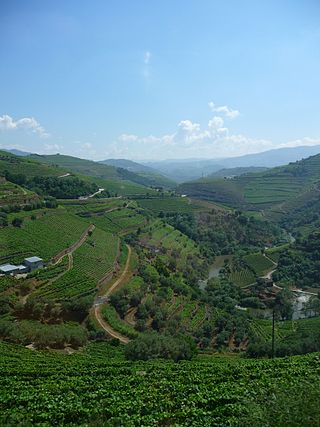
Douro is a Portuguese wine region centered on the Douro River in the Trás-os-Montes e Alto Douro region. It is sometimes referred to as the Alto Douro, as it is located some distance upstream from Porto, sheltered by mountain ranges from coastal influence. The region has Portugal's highest wine classification as a Denominação de Origem Controlada (DOC) and is registered as a Protected Designation of Origin under EU and UK law, and as a Geographical Indication in several other countries through bilateral agreements. While the region is best known for Port wine production, the Douro produces just as much table wine as it does fortified wine. The non-fortified wines are typically referred to as "Douro wines".
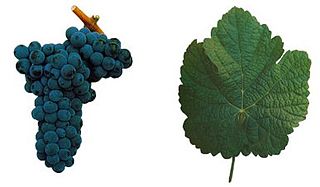
Touriga Francesa is one of the major grape varieties used to produce port wine. Touriga Francesa is lighter and more perfumed than Touriga Nacional, adding finesse to the wine. Touriga Francesa has been described by Jancis Robinson as playing "Cabernet Franc to Touriga Nacional’s Cabernet Sauvignon". It is a cross of two other indigenous Portuguese wine grape varieties Mourisco tinto and Touriga Nacional. Touriga Francesa is quite similar to Touriga Nacional, needing harsh conditions to keep vigor down as it gets on the steep arid slopes of the Douro. It is usually trained low to the ground under one of the Royat systems. Yields are medium (1,5 kg/vine), not as bad as Touriga Nacional.

Mencía, known as Jaen in Portugal, is a grape variety native to the western part of the Iberian Peninsula. In Spain, it is planted on over 9,100 hectares, with another 2,500 hectares in neighboring Portugal. It is primarily found in the Bierzo, Ribeira Sacra, Valdeorras, Monterrei and Dão wine regions.

Tinta Barroca is a Portuguese red wine grape that is grown primarily in the Douro region with some plantings in South Africa and the Riverland wine region of Australia. In Portugal, it is a common blending grape in Port wine while in South Africa and Australia it is normally made into a varietal wine or blend with other grapes. The vine was introduced to the Douro region in the late 19th century and has the advantages of being able to withstand cool conditions while planted on north-facing slopes.

Galician wine is Spanish wine made in the autonomous community of Galicia in the northwest corner of Spain. It includes wine made in the provinces of A Coruña, Ourense, Pontevedra and Lugo. Within Galicia are five Denominacións de Orixe (DO): Monterrei, Rías Baixas, Ribeira Sacra, Ribeiro and Valdeorras. In recent years, the region has seen a resurgence in its wine industry led by the international acclaim being received by the Rías Baixas region for its Albariño wines.
Planalto Mirandes is a Portuguese wine region centered on the town of Miranda do Douro in the Trás-os-Montes e Alto Douro region. The region was initially a separate Indicação de Proveniencia Regulamentada (IPR) region, but in 2006, it became one of three subregions of the Trás-os-Montes DOC, which has the higher Denominação de Origem Controlada (DOC) status. Its name may still be indicated together with that of Trás-os-Montes, as Trás-os-Montes-Planalto Mirandês.
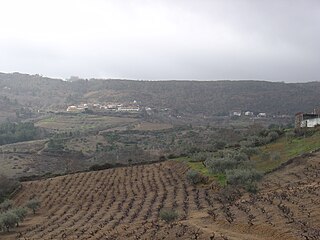
Valpaços is a Portuguese wine region centered on the town of Valpaços in the Trás-os-Montes e Alto Douro region. The region was initially a separate Indicação de Proveniencia Regulamentada (IPR) region, but in 2006, it became one of three subregions of the Trás-os-Montes DOC, which has the higher Denominação de Origem Controlada (DOC) status. Its name may still be indicated together with that of Trás-os-Montes, as Trás-os-Montes-Valpaços. Located along the Tua River, the region is known for its slightly sparkling rosé.

Távora-Varosa is a Portuguese wine region located in the northwestern section of the Beiras region. The region is designated as Denominação de Origem Controlada (DOC) after it was promoted from its former Indicação de Proveniencia Regulamentada (IPR) status, when it was called Varosa IPR. At the same time, the former Encostas da Nave IPR, bordering the Douro, was absorbed into the Távora-Varosa DOC.
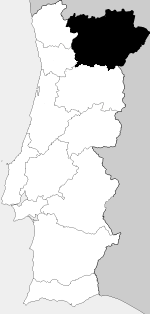
Trás-os-Montes is a Portuguese wine region located in the Trás-os-Montes e Alto Douro region. The entire wine region is entitled to use the Vinho Regional designation Transmontano VR, while some areas are also classified at the higher Denominação de Origem Controlada (DOC) level under the designation Trás-os-Montes DOC. VR is similar to the French vin de pays and DOC to the French AOC.
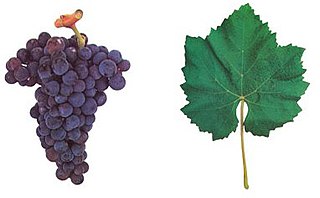
Castelão, in Portugal also known as Periquita and João de Santarém, is a red wine grape found primarily in the south coastal regions but is grown all over Portugal and is sometimes used in Port wine production.

Cayetana blanca, also known as Cayetana or Jaén, is a white Spanish wine grape. It is grown mainly in the south of Spain, especially in Extremadura and in the Jerez region where it is distilled for use in brandy production.
Moreto is a red Portuguese wine grape variety that is planted primarily in the Alentejo. As a varietal, the grape makes neutral wines.
Parraleta is a red Spanish wine grape variety which might also be known under various other names, such as Tinta Caiada in several Mediterranean countries. Parraleta is chosen as a prime name as it was used in Somontano, region located in the north-east Spain, which is its likely place of origin. DNA profiles of Tinta Caiada, and Carenisca, and Salceño Negro with that of Parraleta suggests that they are one and the same variety.
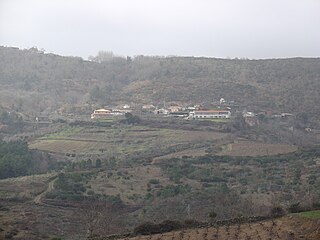
Tinta Carvalha is a red Portuguese wine grape variety that is widely planted throughout Portugal, most notably in the Trás-os-Montes e Alto Douro Province, due to its easy maintenance and high yield potential. It is primarily a blending grape that on its own tends to produce light bodied, nondescript wines. It is an approved grape variety used in Port wine production as well as the non-fortified wines of the Chaves and Valpaços wine region.
Rufete is a red Spanish/Portuguese wine grape variety that is grown primarily used in port wine production in the Douro region of Portugal. It is also grown up along the Duero basin across the border in the Spanish province of Castile and León and can be found in the Dão DOC of Portugal where the variety is known as Tinta Pinheira.
References
- 1 2 "Marufo". Vitis International Variety Catalogue . Retrieved 2010-01-30.
- ↑ J. Robinson Jancis Robinson's Wine Course Third Edition pg 144 Abbeville Press 2003 ISBN 0-7892-0883-0
- ↑ Barrias, Sara; Pereira, Leonor; Rocha, Sara; de Sousa, Tiago Alves; Ibáñez, Javier; Martins-Lopes, Paula (2023-03-01). "Identification of Portuguese traditional grapevines using molecular marker-based strategies". Scientia Horticulturae. 311: 111826. doi: 10.1016/j.scienta.2023.111826 . hdl: 10261/337069 . ISSN 0304-4238.